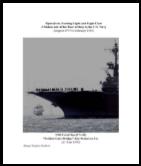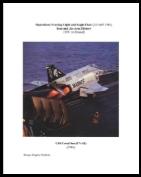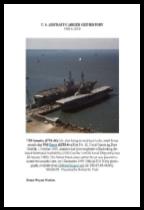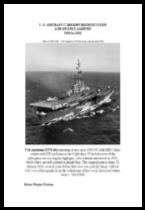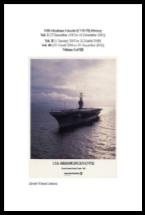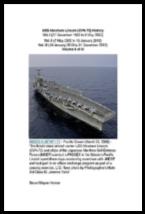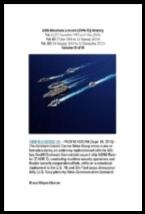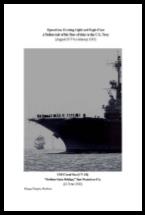





|
CHAPTER II to V (11 September 1945 to 3 January 1949) |


|
A Sailors tale of his Tour of duty in the U.S. Navy (August 1977 to February 1983) Operation Evening Light and Eagle Claw - 4 April 1980
Book - ISBN NO. 978-1-4276-0454-5 EBook - ISBN NO. 978-1-329-15473-5
Operations Evening Light and Eagle Claw (24 April 1980) Iran and Air Arm History (1941 to 1980)
Book ISBN NO. xxxxxxxxxxxxx EBook ISBN NO. 978-1-329-19945-3
U. S. AIRCRAFT CARRIER SHIP HISTORY (1920 to 2019)
Book - ISBN NO. 978-1-4276-0465-1 EBook - ISBN NO. 978-1-365-25019-4 Library of Congress Control Number: 2008901616 (Book Version)
U. S. AIRCRAFT CARRIERS REDESIGNATED AND OR RECLASSIFIED (1953 to 2016)
BOOK - ISBN NO. 978-1-4276-0452-1 EBook - ISBN NO. 978-1-365-25041-5 Library of Congress (Book Version) 2008901619
ENERGY QUEST AND U. S. AIRCRAFT CARRIER DEPLOYMENT HISTORY INVESTMENT CAPITAL REQUIRED TO PUBLISH 55 EIGHTH HUNNDRED PAGE BOOKS, EBOOKS & CD’s (48 Navy Books)
Book - ISBN NO. To Be Announced EBook - ISBN No. 978-1-365-26038-4
USS Abraham Lincoln (CVN-72) History Vol. I of III (27 December 1982 to 6 May 2003)
Book Vol. I of IV ISBN: TBA EBook Vol. I of IV ISBN: 978-1-365-73794-7
USS Abraham Lincoln (CVN-72) History Vol. II of III (7 May 2003 to 13 January 2010)
Book - ISBN NO. To Be Announced EBook - ISBN NO. 978-1-365-74027-5
USS Abraham Lincoln (CVN-72) History Vol. III of III (14 January 2010 to 31 December 2012)
Book - ISBN NO. To Be Announced EBook - ISBN No. 978-1-365-74145-6
USS Coral Sea CV-42 CVB-43 CVA-43 and CV-43 History and Those Aircraft Carriers Operating with Coral Sea During Her Tour of Service CONSTRUCTION to LAUNCHING and EARLY JET AIRCRAFT DEVELOPMENT (10 July 1944—2 April 1946) and a Tour of Duty in the U. S. Navy (August 1977 to February 1983)
ISBN: 9781434382917
|
|
USS Midway (CVB-41) fitted out at the Norfolk Navy Yard from 11 September to 12 October 1945 when she commenced operations from Norfolk Va., after a 40-day period in the yard during which necessary alterations were made; Shakedown Cruise, operating with the Commander-in-Chief, Atlantic Fleet (CinCLant) under under operational control of ComAirLant in the Southern Atlantic and Caribbean Sea (7 November 1945 to 2 January 1946) and conducted operations out of Norfolk, Va., that included CVBG-74 embarked conducting exercises in the area of the Virginia Capes and the Chesapeake Bay (3 January to 28 February 1946). (11 September 1945 to 28 February 1946) CHAPTER II
“USS Midway (CVB-41) remained in the Norfolk Navy Yard for fitting out from 11 September to 12 October 1945 when she commenced operations from Norfolk Va., after a 40-day period in the yard during which time necessary alterations were made, with Joseph Francis Bolger, USNA ’21, as Commanding Officer” (Ref. 1-Midway & 72).
“At 1324, 22 October 1945, USS Midway (CVB-41) with CVBG-74 embarked aircraft landed her first aircraft aboard, a Chance-Vought Corsair (F4U-4) fighter, and at 1630 she catapulted the first plane from her deck. Pilot boat came alongside USS Midway (CVB-41) and Lt. Cdr Seeth, USCG came aboard. Pilot has the conn, Captain, Executive Officer and Navigator on the bridge. Anchored in Gravesend Bay, New York 24 October 1945, to celebrate Navy Day; steaming en route from Norfolk, VA to New York, in company with ComDesdiv. 136 – USS Vogelgesang (DD-862) and USS Steinaker (DD-863)” (Ref. National Archives – Deck Log – Remarks Sheet – October 24, 1945” (Ref. National Archives – Deck Log – Remarks Sheet – October 24, 1945; USS MIDWAY Command History for Calendar Year 15 December 1945).
“USS Midway (CVB-41) with CVBG-74 and ComDesdiv. 136 embarked departed Norfolk Va., on 7 November 1945, operating with the Commander-in-Chief, Atlantic Fleet (CinCLant) under operational control of ComAirLant in the Southern Atlantic, while assigned to Guantanamo Bay, Cuba, with Joseph Francis Bolger, USNA ’21, as Commanding Officer, on her first Shakedown Cruise, steaming in company with ComDesdiv. 136. USS Vogelgesang (DD-862) and USS Steinaker (DD-863) to the Caribbean Sea for Shakedown Cruise, via Gravesend Bay, New York to celebrate Navy Day from 24 to 30 October 1945. She will under go her first Cruise since her commission 10 September 1945, having the destination of being the lead ship of her class, and the first to be commissioned after the end of World War II (7 November 1945 to 2 January 1946)” (Ref. 1-Midway, 72,1082, National Archives – Deck Log – Remarks Sheet – October 24, 1945 & USS MIDWAY Command History for Calendar Year 15 December 1945).
“USS Midway (CVB-41) with CVBG-74 and ComDesdiv. 136 embarked weighed anchor in Gravesend Bay, New York, after celebrating Navy Day from 24 to 30 October 1945, to continue her first Shakedown Cruise, steaming in company with ComDesdiv. 136. USS Vogelgesang (DD-862) and USS Steinaker (DD-863) to the Caribbean Sea for Shakedown Cruise” (Ref. 1-Midway, 72,1082, National Archives – Deck Log – Remarks Sheet – October 24, 1945 & USS MIDWAY Command History for Calendar Year 15 December 1945).
Present for the Shakedown was the following slate of officers:
Captain J. F. Bolger, USN, Commanding Officer. Commander R. C. Bauer, USN, Executive Officer Commander A. H. Wilson, USN, Air Officer Commander J. T. Blackburn, USN, Air Group Commander. Commander H. W. Seely, USN, Gunnery Officer Commander M. Halstead, USN, Engineer Officer Commander L. W. Parrish, USN, Navigator Commander J. P. Domenech, USN, First Lieut., and Damage Control. Commander T. A. Allman, (MC) USN, Senior Medical Officer. Commander H. S. Cone (SC) USN, Supply Officer. Lieut. Comdr. W. W. Winter (ChC) USN, Senior Chaplain Lieut. P. J. Wirsing, USN, Communication Officer (Acting)” (Ref. USS MIDWAY Command History for Calendar Year 15 December 1945).
USS Midway (CVB-41) with CVBG-74 embarked (7 November to 13 December 1945)
“On 13 December 1945, USS Midway (CVB-41) with CVBG-74 and ComDesdiv. 136 embarked arrived Norfolk Va. on 7 November 1945, operating with the Commander-in-Chief, Atlantic Fleet (CinCLant) under operational control of ComAirLant in the Southern Atlantic, while assigned to Guantanamo Bay, Cuba, with Captain Joseph Francis Bolger, USNA ’21, 1st Commanding Officer, serving from September 10, 1945 to Present, ending her first Shakedown Cruise, steaming in company with USS Vogelgesang (DD-862) and USS Steinaker (DD-863), via Gravesend Bay, New York to celebrate Navy Day from 24 to 30 October 1945. She will under go her first Cruise since her commission 10 September 1945, having the destination of being the lead ship of her class, and the first to be commissioned after the end of World War II .Her Caribbean Shakedown Cruise lived up to all expectations, the only negative being a pronounced proclivity to drench the flight deck and the bow 40mm quad mount with green water in moderately heavy seas. Seriously overweight, Midway tended to plunge through, rather than ride over, heavy seas. The result of wartime demands that had continually added more tonnage, Midway quickly earned a reputation as a "wet" ship with her forward flight deck, gun galleries and hangar spaces frequently awash. In her final years, crewmembers described this plunging as "Rock & Roll." Ports of call not reported. Squadrons: VF-74, F4U-4; VBF-74, F6F-5N; VB-74, F4U-4 and VT-74, SB2C-4E, SB2C-5, SBW-4E and SB2C-4E. Her first Cruise since her commission 10 September 1945, having the destination of being the lead ship of her class, and the first to be commissioned after the end of World War II (7 November to 13 December 1945)” (Ref. 1-Midway, 72,1082 & USS MIDWAY Command History for Calendar Year 15 December 1945; USS MIDWAY Command History for Calendar Year 15 December 1945).
07/1145 to 02/01/46
"Operation Frostbite," a cold weather cruise for testing equipment in the frigid region of the North Atlantic on her first Cruise in the North Atlantic extending over an ocean area some 500 miles in diameter between- Greenland, Labrador and the Hudson Strait extending over an ocean area some 500 miles in diameter between- Greenland (1 to 23 March 1946); EIGHTH Fleet exercises on her 2nd Caribbean Sea Cruise in areas off Guantanamo Bay, Cuba, and Culebra Island, Puerto Rico (19 April to 10 June 1946); entered the Norfolk Navy Yard from 11 June 1946 to 4 April 1947, for extensive alterations and the crew began extensive preparations for the launching of V-2 from the flight deck, shifting to Pier 5, at Norfolk, Virginia; Training off the East coast on her 3rd Caribbean Cruise in foreign waters after 4 April 1947 and launch and or firing of a captured German V-2 Rocket from its flight deck in Operation Sandy, first such launching from a moving platform to see if a large rocket could be launched from the deck of an aircraft carrier, carrying a V-2 rocket, several tons of equipment, and a host of military and scientific observers upon departure from Norfolk, Va. (2 to 9 September 1947). (1 March 1946 to 28 October 1947) CHAPTER III
“With the reorganization of the Navy after World War II in December 1945, Eighth Fleet was reactivated on 1 March 1946 under the command of Admiral Marc A. Mitscher. Under the overall command of Commander, U.S. Atlantic Fleet, Eighth Fleet was the heavy striking arm of the Atlantic Fleet. It consisted of the preponderance of Atlantic Fleet aircraft carrier assets, initially including the new fast carriers Midway and Franklin D. Roosevelt, their escorts and support ships. These latter did not include the fast Battleship Division (Battleship Division Two?) made up of USS Wisconsin and Missouri, retained under direct command of Atlantic Fleet” (Ref. 313CH).
“USS Midway (CVB-41) with CVBG-74 and Rear Admiral J.H. Cassady, USN, embarked, departed Norfolk, Virginia, on 1 March 1946, hoisting his flag in Midway, becoming the flagship of Carrier Division ONE (CarDiv 1), with Captain Herbert Spencer Duckworth, USNA ‘22, assumed command during a change of command ceremony aboard Midway on 12 January 1946, relieving Joseph Francis Bolger, USNA ’21, 1st Commanding Officer, serving from September 10, 1945 - January 12, 1946, operating with the U.S. Atlantic Fleet, on her first North Atlantic Cruise, operating with the Commander-in-Chief, Atlantic Fleet (CinCLant), operational control extending to the Eighth Fleet and ComAirLant, steaming in the Davis Straits, this time crossing the Arctic Circle with three destroyers and a fleet oilier testing equipment and techniques for cold weather operations in the North Atlantic, conducting a cold weather evaluation of aircraft, personnel and ships for "Operation Frostbite", a cold weather cruise for testing equipment in the frigid region of the "Operation Frostbite," a cold weather cruise for testing equipment in the frigid region of the North Atlantic, extending over an ocean area some 500 miles in diameter between- Greenland, Labrador and the Hudson Strait extending over an ocean area some 500 miles in diameter between- Greenland, Labrador and the Hudson Strait. She will under go her second Cruise since her commission 10 September 1945, having the destination of being the lead ship of her class, and the first to be commissioned after the end of World War II” (Ref. 1-Midway, 72, 1082 & USS MIDWAY Command History for Calendar Year 1946).
USS Midway (CVB-41) with CVBG-74 (1 to 23 March 1946)
Operation FROSTBITE - March 1946 – Ref. 1088
“Operation FROSTBITE - March 1946, a naval exercise involving U.S. Navy Task Group 21.11 led by the aircraft carrier USS Midway (CVB-41) that operated in the Davis Straits between Labrador and Greenland” (Ref. 1088 & [2] - Midway History and Events: Shake Down and Operation Frostbite of 1088A).
"Operation Frostbite," a cold weather cruise for testing equipment in the frigid region of the North Atlantic extending over an ocean area some 500 miles in diameter between- Greenland, Labrador and the Hudson Strait. Flanked by three destroyers and a fleet oiler, she conducted tests which revealed the actual functioning of various types of aircraft in extreme weather conditions. One of the Navy's new jet-propelled Fireball fighters (FR-l), was also taken along for the experiment. Such innovations to carrier warfare as a helicopter for effecting air-sea rescues, snowplows to operate on the giant flight decks, and baskets attached to cranes projecting from destroyers, devised to snatch pilots from the icy waters were tested.
Each aviator was equipped with new exposure suits recently developed in an effort to protect the fliers forced down in the frigid sea” (Ref. USS MIDWAY Command History for Calendar Year 1946).
Official U.S. Navy Photograph, now in the collections of the National Archives (photo # 80-G-K-10001). Note: Original caption incorrectly identifies the ship as "USS Midway (CVB-42)". CVB-42 was USS Franklin D. Roosevelt. In March 1946, Midway (not Franklin D. Roosevelt) made a cruise to Arctic waters for experimental cold weather operations - NS024115 - Scott Dyben. http://www.navsource.org/archives/02/024115.jpg
“On 23 March 1946, USS Midway (CVB-41) with CVBG-74, Coast Guard helicopter and crew, which signified the first use of a helicopter for plane guard duty and Rear Admiral J.H. Cassady, USN, becoming the flagship of Carrier Division ONE (CarDiv 1), U. S. Atlantic Fleet on 20 February 1946, as flagship embarked arrived Norfolk Va., with Captain Herbert Spencer Duckworth, USNA ’22, as Commanding Officer, ending her first North Atlantic Cruise, operating with the Commander-in-Chief, Atlantic Fleet (CinCLant), operational control extending to the Eighth Fleet and ComAirLant, steaming in the Davis Straits for 23 days, this time crossing the Arctic Circle with three destroyers and a fleet oilier testing equipment and techniques for cold weather operations in the North Atlantic, conducting a cold weather evaluation of aircraft, personnel and ships for "Operation Frostbite," a cold weather cruise for testing equipment in the frigid region of the North Atlantic, extending over an ocean area some 500 miles in diameter between- Greenland, Labrador and the Hudson Strait extending over an ocean area some 500 miles in diameter between- Greenland, Labrador and the Hudson Strait. Helicopter and crew, which signified the first use of a helicopter for plane guard duty. Helicopter air-sea rescue techniques were refined and the infamous "poopy suit" was evaluated. Midway conducted flight and refueling operations during these tests despite heavy weather damage to elevator hangar doors and having two to four inches of snow on the flight deck at various times. Operation FROSTBITE - March 1946. Operation Frostbite (pictured), a 1946 naval exercise involving U.S. Navy Task Group 21.11 led by the aircraft carrier Midway that operated in the Davis Straits between Labrador and Greenland. Midway returned to New York on 23 March 1946 and remainerd until 5 April 1946 prior to resuming operations from Norfolk, Virginia. CVBG-74 redesignated CVBG-1 on 15 November 1946. Squadrons: VF-74 (*2), F4U-4, F6F-5N; VBF-74 (*3), F4U-4; VB-74 (*4), SB2C-4E, SB2C-5; VT-74 (*5), SBW-4E, SB2C-4E and NATC, F8F-1, FR-1 and HNS-1. (*2) Redesignated VF-1B on 15 November 1946; (*3) Redesignated VF-2B on 15 November 1946; (*4) Redesignated VA-1B on 15 November 1946 and (*5) Redesignated VA-2B on 15 November 1946. Her second Cruise since her commission 10 September 1945, having the destination of being the lead ship of her class, and the first to be commissioned after the end of World War II (20 February to 23 March 1946)” (Ref. 1-Midway, 72, 1082, 1088, [2] of 1088A, USS Midway (CV 41) WestPac Cruise Book 1987-89; National Archives – Deck Log – Remarks Sheet – October 24, 1945 & USS MIDWAY Command History for Calendar Year 15 December 1945).
“USS Midway (CVB-41) with CVBG-74, Coast Guard helicopter and crew, which signified the first use of a helicopter for plane guard duty departed New York on 5 April 1946 to resume operations from-Norfolk, Virginia” (Ref. USS MIDWAY Command History for Calendar Year 1946).
“USS Midway (CVB-41) with CVBG-74 and Rear Admiral J.H. Cassady, USN, becoming the flagship of Carrier Division ONE (CarDiv 1), U. S. Atlantic Fleet 20 February 1946, as flagship embarked departed Norfolk, Virginia on 19 April 1946, to take part in EIGHTH Fleet exercises, on her second Caribbean Cruise in areas off Guantanamo Bay, Cuba, and Culebra Island, Puerto Rico. She will under go her first Foreign Water Fleet Deployment (FWFD) since her commission 10 September 1945, having the destination of being the lead ship of her class, and the first to be commissioned after the end of World War II” (Ref. 1-Midway, 72 & USS MIDWAY Command History for Calendar Year 1946).
USS Midway (CVB-41) with CVBG-74 (19 April to 10 June 1946)
“While en route Port of Spain, Trinidad, USS Midway (CVB-41) rendered a 21-gun salute to President Harry S, Truman who joined the task group in USS Franklin D. Roosevelt (CVB-42), flagship of the EIGHTH Fleet on 22 April 1946” (Ref. USS MIDWAY Command History for Calendar Yea 1946).
“After visiting Port of Spain, Trinidad, where the President left the task group, USS Midway (CVB-41) took part in EIGHTH Fleet exercises in the Caribbean Sea in areas off Guantanamo Bay, Cuba, and Culebra Island, Puerto Rico” (Ref. USS MIDWAY Command History for Calendar Yea 1946).
“USS Midway (CVB-41) with CVBG-74 and Rear Admiral J.H. Cassady, USN, becoming the flagship of Carrier Division ONE (CarDiv 1), U. S. Atlantic Fleet 20 February 1946, as flagship embarked returned to Norfolk, Virginia on 10 June 1946 after clearing New York Harbor 10 June 1946, in port New York upon arrival from Training Cruise 27 May 1946, conducting EIGHTH Fleet exercises, ending her second Caribbean Sea Cruise in areas off Guantanamo Bay, Cuba, and Culebra Island, Puerto Rico. While en route on 22 April 1946, Midway rendered a 21-gun salute to President Harry S, Truman who joined the task group in USS Franklin D. Roosevelt (CVB-42), flagship of the EIGHTH Fleet. After visiting Port of Spain, Trinidad, where the President left the task group, Midway took part in EIGHTH Fleet exercises off Guantanamo Bay, Cuba, and Culebra Island, Puerto Rico. Port of calls included: Port of Spain, officially the City of Port of Spain (also stylized Port-of-Spain), is the capital city of Trinidad and Tobago and the country's second-largest city after San Fernando and the third largest municipality after Chaguanas and San Fernando. CVBG-74 redesignated CVBG-1 on 15 November 1946. Squadrons: VF-74 (*2), F4U-4, F6F-5N; VBF-74 (*3), F4U-4; VB-74 (*4), SB2C-4E, SB2C-5; VT-74 (*5), SBW-4E, SB2C-4E and NATC, F8F-1, FR-1 and HNS-1. (*2) Redesignated VF-1B on 15 November 1946; (*3) Redesignated VF-2B on 15 November 1946; (*4) Redesignated VA-1B on 15 November 1946 and (*5) Redesignated VA-2B on 15 November 1946. Her first Foreign Water Fleet Deployment (FWFD) since her commission 10 September 1945, having the destination of being the lead ship of her class, and the first to be commissioned after the end of World War II (19 April to 10 June 1946)” (Ref. 1-Midway, 72 & USS MIDWAY Command History for Calendar Year 1946).
“After operations in the Virginia Capes area and two training cruises to Guantanamo Bay, USS Midway (CVB-41) entered the Norfolk Navy Yard on 11 June 1946, for extensive alterations and the crew began extensive preparations for the launching of V-2 from the flight deck” (Ref. 1175G & USS Midway (CV 41) WestPac Cruise Book 1987-89 and USS MIDWAY Command History for Calendar Year 1946).
“Captain John Perry Whitney, USNA ‘22, assumed command during a change of command ceremony aboard USS Midway (CVA-41) 18 July 1946, relieving Captain Herbert Spencer Duckworth, USNA ‘22, 2nd Commanding Officer, serving from January 12, 1946 - July 18, 1946” (Ref. 1178-G & USS Midway (CV 41) WestPac Cruise Book 1987-89 and USS MIDWAY Command History for Calendar Year 1946).
“USS Midway (CVB-41) training continued off the East coast operating with the Atlantic under the direction of the 8th Fleet in the Atlantic beginning 20 February 1946 through 31 December 1946” (Ref. 1-Midway & 72)
“In January 1947, the U.S. Eighth Fleet was redesignated as the Second Task Fleet, a part of the Atlantic Fleet” (Ref. 313CH & [4] - Lt Col Ronald H. Spector, U.S. Marines in Grenada 1983, History and Museums Division, HQ USMC, 1987, 1.of 313U1).
“USS Midway (CVB-41) was in the Norfolk Navy Yard from 11 June 1946 to 4 April 1947, for extensive alterations and the crew began extensive preparations for the launching of V-2 from the flight deck, shifting to Pier 5, at Norfolk, Virginia” (Ref. 1175G, USS Midway (CV 41) WestPac Cruise Book 1987-89 & USS MIDWAY Command History for Calendar Year 15 December 1946 & 1947).
“Early in 1947, operating off the East Coast with her recently redesignated battle group of the U.S. Eighth Fleet, redesignated as the Second Task Fleet, as part of the Atlantic Fleet, USS Midway (CVB-41) with CVBG-1 embarked, aircraft operated F4U-4B Corsairs and SB2-C-5 Helldivers” (Ref. 1082).
“In early 1947, the first “Dirigible” lands aboard USS Midway (CVB-41)” (Ref. 1081M).
“USS Midway (CVB-41) was in the Norfolk Navy Yard from 11 June 1946 to 4 April 1947, for extensive alterations and the crew began extensive preparations for the launching of V-2 from the flight deck, shifting to Pier 5, at Norfolk, Virginia” (Ref. 1175G, USS Midway (CV 41) WestPac Cruise Book 1987-89 & USS MIDWAY Command History for Calendar Year 15 December 1946 & 1947).
“USS Midway (CVB-41) with CVBG-1 embarked air group continued training off the East coast on her 3rd Caribbean Cruise in foreign waters after 4 April 1947, Captain John Perry Whitney, USNA ‘22, assumed command during a change of command ceremony aboard USS Midway (CVA-41) 18 July 1946, relieving Captain Herbert Spencer Duckworth, USNA ‘22, 2nd Commanding Officer, serving from January 12, 1946 - July 18, 1946, operating with the Commander-in-Chief, Atlantic Fleet (CinCLant) under operational control of Second Task Fleet and ComAirLant. She will under go her third Cruise since her commission 10 September 1945, having the destination of being the lead ship of her class, and the first to be commissioned after the end of World War II” (Ref. [4] - Lt Col Ronald H. Spector, U.S. Marines in Grenada 1983, History and Museums Division, HQ USMC, 1987, 1.of 313U1, USS Midway (CV 41) WestPac Cruise Book 1987-89 & USS MIDWAY Command History for Calendar Year 1947).
USS Midway (CVB-41) with CVBG-74 (After 4 April 1947)
“In June 1947, USS Midway (CVB-42) crew began extensive preparations for the launching of V-2 from the flight deck” (Ref. 1175G).
“USS Midway (CVB-41) with CVBG-1 embarked air group continued training off the East coast and in the Caribbean Sea in foreign waters, operating with the Commander-in-Chief, Atlantic Fleet (CinCLant) under operational control of Second Task Fleet and ComAirLant” (Ref. .[4] - Lt Col Ronald H. Spector, U.S. Marines in Grenada 1983, History and Museums Division, HQ USMC, 1987, 1.of 313U1).
“Captain Albert Kellogg Morehouse, USNA ‘22, assumed command during a change of command ceremony aboard USS Midway (CVA-41) 11 August 1947, relieving Captain John Perry Whitney, USNA ‘22, 3rd Commanding Officer, serving from September 10, 1945 - January 12 to 18 July 1946” (Ref. 1178-G, USS Midway (CV 41) WestPac Cruise Book 1987-89 & USS MIDWAY Command History for Calendar Year 1947).
“Rear Admiral John Jennings Ballentine, U.S.N., Commander Carrier Division One exercises command of the administration and operating functions of the ships and units of Carrier Division One, which consists of his flag ship USS Midway (CVB-41), the USS Franklin D. Roosevelt (CVB-42) and the Air Groups and Aircraft Squadrons of each of these ships” (Ref. 1175A, 1175F, USS Midway (CV 41) WestPac Cruise Book 1987-89 & USS MIDWAY Command History for Calendar Year 1947).
“USS Midway (CVB-42) conducted three training cruises in the Caribbean Sea before sailing from her homeport at Norfolk, Virginia, on another experimental mission” (Ref. 1082).
“USS Midway (CVB-41) sailed from Norfolk, Va. on 2 September 1947, with CVBG-1 and flagship of Commander Carrier Division One, Commander Task Force 81, Rear Admiral John Jennings Ballentine, U.S.N. embarked, with Captain Albert Kellogg Morehouse, USNA ‘22, assuming command during a change of command ceremony aboard Midway on 11 August 1947, relieving Captain John Perry Whitney, USNA ‘22, 3rd Commanding Officer, serving from September 10, 1945 - January 12 to 18 July 1946, operating with the Atlantic under the direction of the 8th Fleet during 1947, extending training operations into the fall, to fire and launch a captured German V-2 Rocket from its flight deck in Operation Sandy, first such launching from a moving platform to see if a large rocket could be launched from the deck of an aircraft carrier, carrying a V-2 rocket, several tons of equipment, and a host of military and scientific observers upon departure from Norfolk, Va.” (Ref. 1175A, 1175F, USS Midway (CV 41) WestPac Cruise Book 1987-89 & USS MIDWAY Command History for Calendar Year 1947).
USS Midway (CVB-41) with CVBG-74 (2 to 9 September 1947)
“USS Midway (CVB-41) arrived off the Narrows of Bermuda Island on 4 September 1947, to receive observers which included the Commander-in-Chief of the U.S. Atlantic Fleet, Admiral W.H.P. Blandy; Doctor F. Hovde, President of Duke University; leading military personnel. in; the field of guided missiles; and representatives of the General Electric and Bell Research Laboratories, After a brief stop in Bermuda, the Midway got underway at 1420, screened by the destroyers USS Larson (DD-830), USS Hanson (DD-832) and USS Thomas (DD-833), for the launching area and successfully launched the first V-2 rocket ever fired from the deck of a ship” (Ref. 1175G, USS Midway (CV 41) WestPac Cruise Book 1987-89 & USS MIDWAY Command History for Calendar Year 1947).
“At 1554, 6 September 1947, screened by the destroyers USS Larson (DD-830), USS Hanson (DD-832) and USS Thomas (DD-833), for the launching area and accompanied by a host of scientific and military observers with tons of equipment embarked USS Midway (CVB-42) conducts Operation Sandy and successfully fires a captured German V-2 rocket from thee flight deck; the first time such weapon is fired from a ship at sea or moving platform. Thus, Midway, while operating as flagship of Commander Task Force 81, with CVBG-1 and Task Force 81 embarked, added another first to her impressive record-that of being the first ship to launch a captured Germa V-2 Rocket from its flight deck in Operation Sandy, the feasibility of launching such missiles from shipboard was proved. The actual ship launch test was only conducted once. There were prior tests carried out at White Sands on a simulated aircraft carrier deck to see what effects the rocket would have if it were to explode on the deck. This test marked the first time such a weapon was fired from a ship at sea or a moving platform. It decisively demonstrated the potential of large rocket fire from surface ships” (Ref. 1175B, 1081K, 1082, USS Midway (CV 41) WestPac Cruise Book 1987-89 & USS MIDWAY Command History for Calendar Year 1947). https://www.navysite.de/cruisebooks/cv41-88/index.html / https://www.navysite.de/cruisebooks/cv41-88/002.htm
“On 9 September 1947, USS Midway (CVB-41) with CVBG-1 and flagship of Commander Carrier Division One, Commander Task Force 81, Rear Admiral John Jennings Ballentine, U.S.N. embarked returned to Norfolk, Va., with Captain Albert Kellogg Morehouse, USNA ‘22, assuming command during a change of command ceremony aboard Midway on 11 August 1947, relieving Captain John Perry Whitney, USNA ‘22, 3rd Commanding Officer, serving from September 10, 1945 - January 12 to 18 July 1946, with several tons of equipment, conducting the launch and or firing of a captured Germa V-2 Rocket from its flight deck in Operation Sandy, first such launching from a moving platform to see if a large rocket could be launched from the deck of an aircraft carrier, carrying a V-2 rocket, several tons of equipment, and a host of military and scientific observers upon departure from Norfolk, Va. Midway arrived off the Narrows of Bermuda Island on 4 September 1947, to receive observers which included the Commander-in-Chief of the U.S. Atlantic Fleet, Admiral W.H.P. Blandy; Doctor F. Hovde, President of Duke University; leading military personnel.in; the field of guided missiles; and representatives of the General Electric and Bell Research Laboratories, After a brief stop in Bermuda, the Midway got underway at 1420, screened by the destroyers USS Larson (DD-830), USS Hanson (DD-832) and USS Thomas (DD-833), for the launching area and successfully launched the first V-2 rocket ever fired from the deck of a ship at 1554, 6 September 1947, when a captured German V-2 rocket was fired from the flight deck of Midway, marking the first time such a large bombardment rocket had been launched from ships or from a moving platform. With the launching of the V-2 from the after end of the flight deck, the feasibility of launching such missiles from shipboard was proved. The actual ship launch test was only conducted once. There were prior tests carried out at White Sands on a simulated aircraft carrier deck to see what effects the rocket would have if it were to explode on the deck. This test marked the first time such a weapon was fired from a ship at sea or a moving platform. It decisively demonstrated the potential of large rocket fire from surface ships. Midway debarked her passengers on 7 September 1947 at Bermuda Island and returned to Norfolk, Va. Squadrons: VF-1B, F4U-4 & F6F-5N; VF-2B, F4U-4; VA-1B, SB2C-4E & SB2C-5; VA-2B, SBW-4E & SB2C-4E and NATC, F8F-1, FR-1 & HNS-1 (2 to 9 September 1947)” (Ref. 1175A,1175B, 1175F, 1081K, 1082, USS Midway (CV 41) WestPac Cruise Book 1987-89 & USS MIDWAY Command History for Calendar Year 1947). https://www.navysite.de/cruisebooks/cv41-88/index.html / https://www.navysite.de/cruisebooks/cv41-88/002.htm “USS Midway (CVB-42) conducted three training cruises in the Caribbean Sea before sailing from her homeport at Norfolk, Virginia, on another experimental mission” (Ref. 1082).
First Mediterranean Sea deployment (29 October 1947 to 11 March 1948); Local Operations (12 to 22 March 1948); Overhaul in the Norfolk Navy Yard (22 March to 30 September 1948) and Local Operations (1 to 7 October 1948). (29 October 1947 to 7 October 1948) CHAPTER IV
“USS Midway (CVB-41) with Rear Admiral John Jennings Ballentine, U.S.N., Commander Carrier Division One and Commander, Carrier Air Group One (CVBG-1) embarked departed Norfolk Va. 29 October 1947, with Captain Albert Kellogg Morehouse, USNA ’22, as Commanding Officer and Commander Forsyth Massey, U.S.N., as Executive Officer, on her first Mediterranean Sea deployment, operating with the 6th Fleet, steaming through the Atlantic to participate in Second Task Fleet maneuvers while enroute to Argentia, Newfoundland and then steamed from that port for her first tour of duty in the Mediterranean with the U. S. Sixth Fleet, operating with the Commander-in-Chief, Atlantic Fleet (CinCLant) (and after 1 December 1947, under a reorganization act of the Armed Forces approved by Congress, the unified U.S. Atlantic Command (USLANTCOM) (Atlantic Fleet) was established with headquarters co-located to those of U.S. Atlantic Fleet. Admiral William H.P. Blandy, USN, Commander in Chief, U.S. Atlantic Fleet, became the first Commander in Chief, U.S. Atlantic Command, a title that remained dual-hatted (and would later become triple-hatted), operational control extending to the Second Task Fleet and ComAirLant. She will under go her second Foreign Water Fleet Deployment (FWFD) since her commission 10 September 1945, having the destination of being the lead ship of her class, and the first to be commissioned after the end of World War II” (Ref. 1-Midway, 72, 313B2, 1175, 1175A, 1175B, 1175C, 1175F & 1175G).
USS Midway (CVB-41) Mediterranean Cruise Book 1947-48 – Ref. 1175 Cruise Map (29 October to 11 March 1948) – Ref. 1175D The Marines – Ref. 1175A Flight Operations – Ref. 1175B Plan of the Day – Ref. 1175C
USS Midway (CVB-41) with CVBG-1 (M) (29 October 1947 to 11 March 1948)
“USS Midway (CVB-41) steamed from Argentia, Newfoundland and then steamed from that port for her first tour of duty in the Mediterranean with the U. S. Sixth Fleet, arriving at Gibraltar on 17 November 1947” (Ref. USS MIDWAY Command History for Calendar Year 1947).
“On 18 February 1948, a USS Midway (CVB-41) liberty launch capsized in heavy waves while attempting to return to the Midway off Gulf D'Hyeres, France, killing eight” (Ref. 84A & 1082).
“USS Midway (CVB-41) departed Gibraltar on 2 March 1948” (Ref. USS MIDWAY Command History for Calendar Year 1948).
A Vought F4U-4 Corsair of Fighter Squadron VF-1B, assigned to Battle Carrier Air Group One (CVBG-1), aboard USS Midway (CVB-41). The aircraft carrier was on her first deployment, 29 October 1947–11 March 1948, to the Mediterranean Sea. VF-1B was redesignated VF-21 on 1 September 1948. Photo by Charles J. Beggy, Jr., Electronics Technician Second Class, USN (Ret.). NS0241aj. Submitted by: Courtesy of Troy Prince, MidwaySailor.com and Charles J. Beggy, Jr., Midway Memories, via Robert Hurst. http://www.navsource.org/archives/02/0241aj.jpg
“On 11 March 1948, USS Midway (CVB-41) with Rear Admiral John Jennings Ballentine, U.S.N., Commander Carrier Division One and Commander, Carrier Air Group One (CVBG-1) embarked arrived Norfolk Va., with Captain Albert Kellogg Morehouse, USNA ’22, as Commanding Officer and Commander Forsyth Massey, U.S.N., as Executive Officer, ending her first Mediterranean Sea deployment, operating with the 6th Fleet, steaming through the Atlantic to participate in Second Task Fleet maneuvers while enroute to Argentia, Newfoundland and then steamed from that port for her first tour of duty in the Mediterranean with the U. S. Sixth Fleet, operating with the Commander-in-Chief, Atlantic Fleet (CinCLant) (and after 1 December 1947, under a reorganization act of the Armed Forces approved by Congress, the unified U.S. Atlantic Command (USLANTCOM) (Atlantic Fleet) was established with headquarters co-located to those of U.S. Atlantic Fleet. Admiral William H.P. Blandy, USN, Commander in Chief, U.S. Atlantic Fleet, became the first Commander in Chief, U.S. Atlantic Command, a title that remained dual-hatted (and would later become triple-hatted), operational control extending to the Second Task Fleet and ComAirLant to the Mediterranean Sea. Steamed from Argentia, Newfoundland and then steamed from that port for her first tour of duty in the Mediterranean with the U. S. Sixth Fleet, arriving at Gibraltar on 17 November 1947. On 18 February 1948, a Midway liberty launch capsized in heavy waves while attempting to return to the Midway off Gulf D'Hyeres, France, killing eight. Midway put into her log on several occasions, the take-off from her huge armor-plated flight deck of the Navy’s P2V Neptune Plane (Patrol), thus giving the United States a most potent weapons carrier–a bomber operating from a mobile airfield. This cruise was hall-marked when Commander F. L. Ashworth flew a P2V-3 from Midway off the coast of Norfolk, Va. to the Panama Canal, then over Corpus Christi, Texas, and on to San Diego, California. CDR Ashworkth completed this 4,800 mile non-stop in 25 hours and 40 minutes. Midway departed Gibraltar on 2 March 1948. Flagship of Carrier-Division ONE her operations in the Mediterranean included visits to Ports of call include: Argentia, Newfoundland; Gibraltar, a British overseas territory located on the southern end of the Iberian Peninsula at the entrance of the Mediterranean; Bone, Algeria, capital of Annaba prov., extreme NE Algeria, a port on the Mediterranean Sea; Marsaxlokk Harbor, Malta Area, a Southern European country consisting of an archipelago situated in the centre of the Mediterranean, 80 km (50 mi) south of Sicily, 284 km (176 mi) east of Tunisia and 333 km (207 mi) north of Libya (Gibraltar lies 1,755 km (1,091 mi) to the west and Alexandria 1,508 km (937 mi) to the east); Genoa (/ˈdʒɛnoʊ.ə/ JEN-oh-ə; Italian: Genova [ˈdʒɛːnova]; Ligurian: Zêna [ˈzeːna]; English, historically, and Latin: Genua) is the capital of the Italian region of Liguria and the sixth-largest city in Italy, the Province of Genoa, stretching along the Italian Riviera; Naples, Italy, the capital of Campania and the third-largest municipality in Italy; Cannes, a city located in the French Riviera, France (Paris, France and Monte Carlo) (Gulf D'Hyeres) / Hyères (French pronunciation: [jɛːʁ]), Provençal Occitan: Ieras in classical norm, or Iero in Mistralian norm) is a commune in the Var department in the Provence-Alpes-Côte d'Azur region in southeastern France. The old town lies 4 km (2.5 mi) from the sea clustered around the Castle of Saint Bernard, which is set on a hill. Between the old town and the sea lies the pine-covered hill of Costebelle, which overlooks the peninsula of Giens; Rome (Latin and Italian: Roma [ˈroːma]) is the capital city and a special comune of Italy (named Comune di Roma Capitale). Rome also serves as the capital of the Lazio region, it is also the country's most populated comune. It is the centre of the Metropolitan City of Rome, Rome is located in the central-western portion of the Italian Peninsula, within Lazio (Latium), along the shores of the Tiber; Augusta, Sicily, a town and comune in the province of Syracuse, located on the eastern coast of Sicily (Italy). The city is one of the main harbours in Italy; a second time at Malta, an island strategically located about halfway between Europe and Africa, and Gibraltar and Alexabdria; Taranto, Italy, a coastal city in Apulia, Southern Italy, the capital of the Province of Taranto and is an important commercial port as well as the main Italian naval base; Augusta, Sicily, a town and comune in the province of Syracuse, located on the eastern coast of Sicily (Italy). The city is one of the main harbours in Italy and Gibraltar. Squadrons: VF-1B (*2), F4U-4; VF-2B (*3), F4U-4; VA-1B (*4)(*5), AD-1 and VA-2B (*6), AD-1. CVBG-1 redesignated CVG-2 on 1 September 1948; (*2) Redesignated VF-21 on 1 September 1948; (*3) Redesignated VF-22 on 1 September 1948; (*4) Redesignated VA-24 on 1 September 1948; (*5) Redesignated VF-24 on 1 December 1949 and (*6) Redesignated VA-25 on 1 September 1948. Her second Foreign Foreign Water Fleet Deployment since her commission 10 September 1945, having the destination of being the lead ship of her class, and the first to be commissioned after the end of World War II (29 October 1947 to 11 March 1948)” (Ref. 1-Midway, 72, 313B2, 1175, 1175A, 1175B, 1175C, 1175F, 1175G, 1081K & 1082). 29/10/47 to 11/03/48
“As the three Midways periodically operated in the Mediterranean Sea, a scheme was undertaken to provide the Navy with a carrier-based nuclear strike capability. The P2V Neptune patrol bomber could carry a Mark 8 atomic bomb—a version of the Little Boy weapon used at Hiroshima. Test launches of Neptunes with rocket boosters began in April 1948, demonstrating that a Neptune could take off from a Midway with a gross weight of 74,000 pounds, deliver an atomic weapon on a target 2,200 miles away, and either return to the carrier and ditch nearby or fly off in a different direction to come down near a rescue ship or submarine work” (Ref. 1083).
“USS Midway (CVB-41) commenced Overhaul in the Norfolk Navy Yard on 22 March 1948” (Ref. USS MIDWAY Command History for Calendar Year 1948).
“Commander Forsyth Massey, USNA ‘31, assumed command during a change of command ceremony aboard USS Midway (CVA-41) on 22 April 1948, relieving Captain Albert Kellogg Morehouse, USNA ‘22, 4th Commanding Officer, serving from August 11, 1947 - April 22, 1948.
Commander Raymond Neil Sharp, USNA ‘30, assumed command during a change of command ceremony aboard USS Midway (CVA-41) on 28 May 1948, relieving Commander Forsyth Massey, USNA ‘31, 5th Commanding Officer, serving from April 22, 1948 - May 28, 1948.
Captain Marcel Emil Adan Gouin, USNA ‘24, assumed command during a change of command ceremony aboard USS Midway (CVA-41) on 7 September 1948, relieving Commander Raymond Neil Sharp, USNA ‘30, 6th Commanding Officer, serving from May 28, 1948 - September 7, 1948” (Ref. 1178-G).
“USS Midway (CVB-41) conducted Overhaul in the Norfolk Navy Yard from 22 March to 30 September 1948” (Ref. USS MIDWAY Command History for Calendar Year 1948).
First Mediterranean Sea deployment (1947-48) Senior Command and Staff CHAPTER IV Appendix I
USS Midway (CVB 41) Mediterranean Cruise Book 1947-48 |
|||||||||||||||||||||||||||||||||||||||||||||||||||||||||||||||||||||||||||||||||||||||||||||||||||||||||||||||||||||||||||||||||||||||||||||||||||||||||||||||||||||||||||||||||||||||||||||||||||||||||||||||||||||||||||||||||||||||||||||||||||||||||||||||||||||||||||||||||||||||||||||||||||||||||||||||||||||||||||||||||||||||||||||||||||||||||||||||||||||||||||||||||||||||||||||||||||||||||||||||||||||||||||||||||||||||||||||||||||||||||
|
Hull No. / Fleet |
Foreign Water Fleet Deployment |
Air Wing |
Tail Code |
Depart |
Return |
Days at Sea Fleet D. No. |
|
USS Midway (CVB-41) – Second Task Fleet |
Lant 4th Caribbean Sea |
CVBG-6 |
C |
8 Oct 1948 |
23 Nov 1948 |
South America Training 4th Cruise 47-days |
|
|
|
SQUADRON |
SQUADRON NICK NAME & PRIMARY ROLE |
AIRCRAFT DESIGN NICK NAME & PRIMARY ROLE |
TAIL CODE Modex |
AIRCRAFT DESIGNATION |
|
VF-61 |
Jolly Rogers - Fighting Plane Squadron or Fighting Squadron |
Grumman - Bearcat REG: N-700A - Interceptor - Night Fighter |
C100 |
F8F-2 2N/2P |
|
VF-62 (*1) |
Fighting Plane Squadron or Fighting Squadron |
Grumman - Bearcat REG: N-700A - Fighter |
C200 |
F8F-2 |
|
VF-63 (*2) |
Fighting Redcocks - Attack Squadron |
Grumman - Bearcat REG: N-700A - Fighter |
C300 |
F8F-2 |
|
VA-64 (*3) (*4) (*5) |
Attack Squadron |
Douglas - Skyraider – Attack |
C400 |
AD-1 |
|
VA-65 |
Attack Squadron |
Douglas - Skyraider - Attack |
C500 |
AD-1 |
|
(*1) VF-62 redesignated VA-106 on Jul.1, 1955 |
||||
|
(*2) VF-63 edesignated VA-63 on Mar.1956 |
||||
|
(*3) VA-64 redesignated VC-24 on Apr.8, 1949 |
||||
|
(*4) VC-24 redesignated VS-24 on Apr.20, 1950 |
||||
|
(*5) VS-24 disestablished on Jun.1, 1956 |
||||
“On 23 November 1948, USS Midway (CVB-41) Rear Admiral John Jennings Ballentine, U.S.N., Commander Carrier Division One and Commander, Carrier Air Group Six (CVBG-6) embarked arrived Norfolk Va., with Captain Marcel Emil Adan Gouin, USNA ‘24, as Commanding Officer, ending her fourth Caribbean Sea Cruise operating with the U.S. Atlantic Command (USLANTCOM) (Atlantic Fleet), operational control extending to the Second Task Fleet and ComAirLant. Ports of call not reported. Squadrons: VF-61, F8F-2 / 2N/2P; VF-62 (*1), F8F-2 / 2N/2P; VF-63 (*2), F8F-2, VA-64 (*3) (*4) (*5), AD-1 and VA-65, AD-1. (*1) VF-62 redesignated VA-106 on Jul.1, 1955; (*2) VF-63 redesignated VA-63 on Mar.1956; (*3) VA-64 redesignated VC-24 on Apr.8, 1949; (*4) VC-24 redesignated VS-24 on Apr.20, 1950 and (*5) VS-24 disestablished on Jun.1, 1956. Her fourth Cruise since her commission 10 September 1945, having the destination of being the lead ship of her class, and the first to be commissioned after the end of World War II (8 October to 23 November 1948)” (Ref. 1-Midway, 72 & 1178-G).
“USS Midway (CVB-41) conducted exercises off the Virginia Capes from 24 November 1948 to 3 January 1949” (Ref. USS MIDWAY Command History for Calendar Year 1948).
